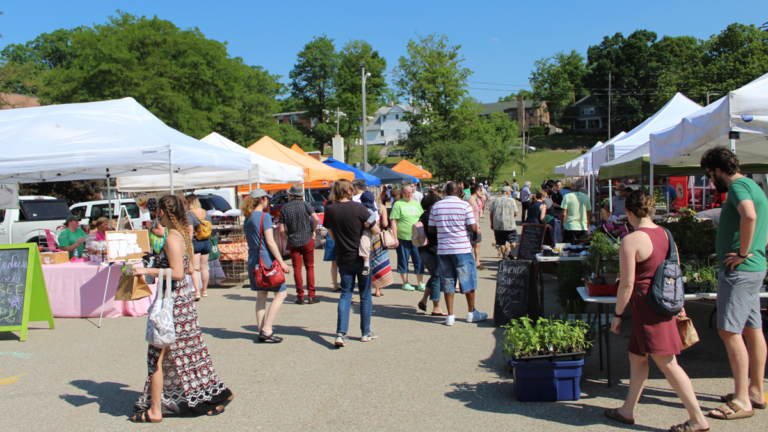For some Midwesterners, farmers markets are a quintessential summertime tradition touting local, healthy food and laid-back community gathering spaces.
But people of color say many markets aren’t designed with them in mind, and in fact, systematically exclude them from participating. That’s why the Farmers Market Coalition gathered a group of experts to design an anti-racist toolkit to help markets transform into more welcoming, inclusive spaces.

“[The goal is] to get people thinking,” said Julialynne Walker, a market manager based in Columbus, Ohio, who helped design the toolkit. “Like in terms of messaging, you know, how do you step back and look at the kinds of material you’re using, look at your market, look at the vendors, and at each level the process. Ask yourself, ‘What is the message being sent if I were to look at this from a different perspective?’”
Although calls for a more equitable and welcoming farmers market system have existed for years, the Farmers Market Coalition began working on the toolkit in the fall of 2020, when much of the nation’s focus turned to racial justice following George Floyd’s murder.
Market managers, vendors and shoppers of color alike say they don’t feel welcome at most farmers markets due to exclusive messaging, market locations and even product availability.
“A couple of times, I would walk in and say, ‘Which vendor has okra?’ or ‘Which vendor has collard greens?’ And they would just look at me, ‘Well, none of our vendors,’” Walker said. “Well, I don’t want kale! You know, so if you really want to attract a particular market, then it’s important to have the foods that that market wants, otherwise we won’t come.”
Part of the problem is the lack of Black, Indigenous and People of Color (BIPOC) vendors at farmers markets – due in large part to systematic discrimination in the agriculture field.
“I can only speak for my market, but when I walk around, there might be one or two vendors from a Hispanic descent or ethnic group, but there are no Black vendors being represented,” said Karla Forrest-Hewitt, a farmers market manager in East Lansing, Michigan, who also helped with the toolkit.
Ensuring that people from all backgrounds feel welcome and represented at their local farmers market is not only a fundamental right – it’s also a community health issue, Forrest-Hewitt said.
“There’s a disparity in chronic health issues and lifestyle issues that can be reduced or helped by access to healthy food,” she said. “So by creating more welcoming spaces, it will help uplift the entire community.”
While the newly-released toolkit hasn’t been widely implemented yet, many Midwestern markets have taken steps to become more inclusive over the past few years.
In Illinois, market managers are working to better advertise to Supplemental Nutrition Assistance Program recipients, whose benefits are worth quadruple at some farmers markets than at the grocery store. SNAP recipients’ attendance at Illinois farmers markets has increased as a result.
And in Nebraska, local food groups recently received a grant from the U.S. Department of Agriculture to reach underserved populations in their market advertising. They created a website in Spanish that includes a map of all the farmers markets in the state, and have also run print, digital and social media advertisements to reach Spanish-speaking populations.
Despite these efforts, experts say farmers markets – especially in the Midwest – have a long way to go. Michigan-based market manager Forrest-Hewitt said she hopes someday farmers markets here look a little more like the ones in her home country, Jamaica.
“I have three little boys, and I want them to have the same access to healthy food that I did when I was growing up,” she said. “Because in Jamaica … when you go to the market, everybody looks like you.”
Follow Dana on Twitter @DanaHCronin
This story was produced in partnership with Harvest Public Media, a collaboration of public media newsrooms in the Midwest. It reports on food systems, agriculture and rural issues. Follow Harvest on Twitter: @HarvestPM.
9(MDM5MjE5NTg1MDE1Mjk1MTM5NjlkMzI1ZQ000))

